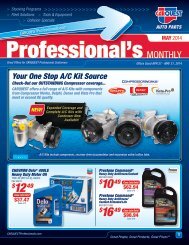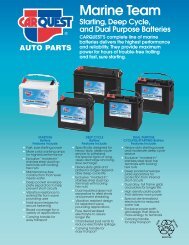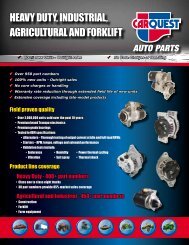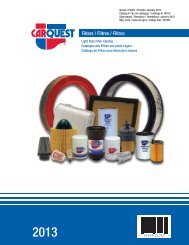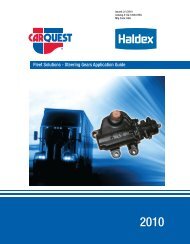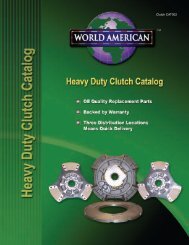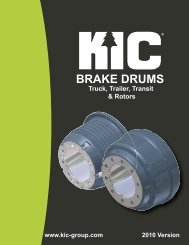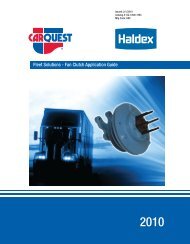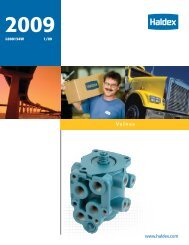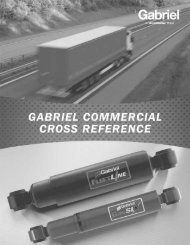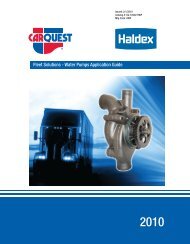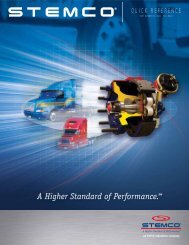Battery Application Guide - CARQUEST Auto Parts
Battery Application Guide - CARQUEST Auto Parts
Battery Application Guide - CARQUEST Auto Parts
- No tags were found...
Create successful ePaper yourself
Turn your PDF publications into a flip-book with our unique Google optimized e-Paper software.
<strong>CARQUEST</strong> SALES INFORMATION<strong>Battery</strong> DesignsBatteries are designed in many different ways to meet the uniquedemands of various applications. Knowing these designs can helpyou make well-informed recommendations concerning customerneeds and vehicle requirements.Top Terminal BatteriesThese batteries have terminal posts on top to enable a cableconnection to the top of the battery. This top post design is builtto Society of <strong>Auto</strong>motive Engineers’ Standards (SAE) so that allcable clamps will fit any battery with these posts. The positiveterminal is slightly larger than the negative to minimize the dangerof installing a battery in reverse. This design is used in almost allnon-GM vehicles.Maintenance Accessible BatteriesBatteries designed with removable vent caps to allow the periodicaddition of water to the electrolyte. Always make sure removablevent caps are tight and level except when servicing electrolyte.Vent caps have a flame-retardant design to help reduce the risk ofbattery explosion that is only effective if properly installed.Dry-Charged BatteriesDry-charged batteries must be filled with electrolyte or “activated”and then boosted before being placed in service. The battery’splates are pre-charged so they become activated after theelectrolyte is added. The advantage of dry-charged batteries isthat they can be held in stock for long periods of time withouthaving to be boost charged.Side Terminal BatteriesThese batteries have terminals molded into the side wall of thecontainer near the top edge. Each battery cable is attached to theterminal by a bolt, which threads into the terminal. With theterminal on the battery’s side, instead of the top, the overallheight of the battery is reduced. To obtain a good electricalcontact without damaging the terminal socket, never use boltsin the side terminals longer than the original side terminal bolts.Too long of a bolt will pierce the side terminal and cause a leak.Do not over-tighten bolts. Use a torque wrench setting between6 to 8 foot-pounds. A side terminal design is almost exclusivelyused in GM vehicles.Dual Terminal BatteriesBatteries with both top and side terminals are called DualTerminal batteries. This universal design provides greaterflexibility for installation by fitting applications requiring eithertop or side terminal batteries. This design helps reduce thenumber of SKU’s required to fit replacement battery needs.Starting, Lighting, and Ignition (S.L.I.)These are the three basic functions a battery has to perform toservice most vehicles. Batteries that fall under the S.L.I.description are designed for the voltage controlled electricalsystem found in passenger cars, light trucks and vans.Commercial BatteriesSimilar in design to S.L.I., these batteries are built with a morepowerful and robust construction than automotive batteries.Many commercial applications require higher cranking amps andadditional power for auxiliary loads. Typically they are constructedwith heavier plates, more active material and thicker separators.Maintenance-Free BatteriesA low water loss, calcium lead-alloy battery designed to relieve theconsumer of routine maintenance requirements such as wateringduring service life of the battery. In fact, the water loss is lowenough that the venting system can be completely sealed, exceptfor small vent holes that relieve internal gas pressure. Wateradditions are not necessary for the life of the battery. Oneadvantage of calcium maintenance-free batteries is prolongedshelf life reducing the need for activation and boost chargingprior to installation. Other advantages include greater overchargeresistance, reduced terminal corrosion and the elimination ofoverfilling or adding harmful impurities.Wet/Flooded BatteriesBatteries that are filled at the factory and shipped “ready to install.”However, wet/flooded batteries will discharge while setting ininventory. Be sure to check voltage and boost charge if opencircuit voltage is below 12.4 Volts. Wet/Flooded batteries are themost widely used in automotive applications. They are usuallyless expensive than Gel or AGM batteries, but do not providethe same cycle life and convenience. Some wet/flooded batteriesrequire maintenance (See Maintenance Accessible Batteries).SVR GelSealed, Valve-Regulated (SVR) Gelled electrolyte batteries offermany significant advantages over conventional “flooded” batteries.Gel batteries are spillproof and leakproof, and resist over-dischargesthat can shorten the life of the battery. Gel batteries havea very low self-discharge rate so they can go longer withoutrecharging. They provide ample cranking amperage and auxiliarypower. Their SVR design minimizes gassing, making them safeto install around people and sensitive electronic equipment. Gelbatteries are maintenance-free and must never be opened.Opening the battery will void the warranty and cause damage.SVR Absorbed Glass Mat (AGM)Sealed, Valve-Regulated (SVR) Absorbed Glass Mat (AGM)batteries use special absorbed electrolyte technology that issuperior to flooded lead-acid batteries. Fine, highly porous microfiberglass separators absorb the electrolyte, increasing efficiencyby lowering internal resistance and boosting capacity. Lowerinternal resistance also means that the batteries can be rechargedfaster than conventional batteries, allowing the user to put themback into operation sooner. The completely sealed, valve-regulatedAGM battery eliminates gas emissions and acid leakage for longerand safer battery operation. AGM batteries are also completelymaintenance-free and must never be opened. Opening the batterywill void the warranty and cause damage.REFERENCE255



